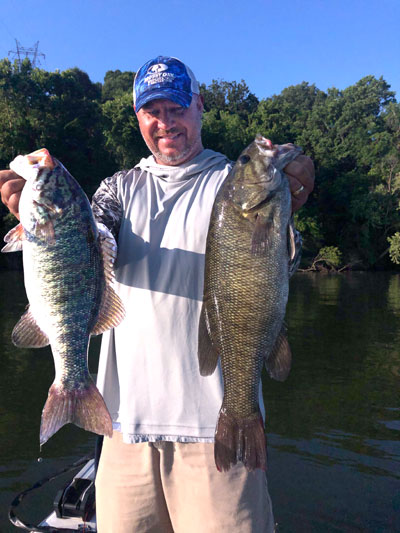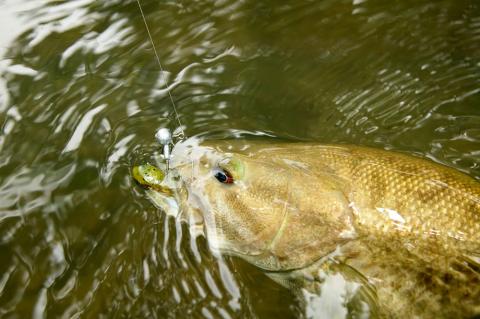provided by John Phillips
One of the best big smallmouth bass waters is the Tennessee River, especially the southern half that runs through north Alabama, west Mississippi and south Tennessee. The two lakes that get the most publicity and produce the biggest smallmouths are Pickwick and Wilson lakes. However, these two lakes not only produce great smallmouth fishing, but equally as good, if not better, largemouth, spotted, hybrid saltwater and striped bass fishing and catfishing. Brad Whitehead of Muscle Shoals, Alabama, guides for smallmouths and other fish. To learn more about Whitehead, visit his Facebook page.
 One of the easiest places to find the threadfin shad is up close to the dam. Look for an eddy, and that’s generally where the shad will hold out of the current. If there’s a boat launch below the dam, that’s a great place to look for schools of these shad. If you can’t see the shad, use your electronics to see them. I like Humminbird electronics, and I put my trolling motor in the water to get me closest to the shad without spooking them.
One of the easiest places to find the threadfin shad is up close to the dam. Look for an eddy, and that’s generally where the shad will hold out of the current. If there’s a boat launch below the dam, that’s a great place to look for schools of these shad. If you can’t see the shad, use your electronics to see them. I like Humminbird electronics, and I put my trolling motor in the water to get me closest to the shad without spooking them.
The real secret to having the best bait you can have, is not only keeping the shad alive, but keeping them lively. I use a tank called an X-Treme Bait Tank that’s made in Kentucky. Not only is the tank insulated, but it also has a filter bag in it to keep the water extremely clean. It also enables the water to stay cool in the tanks. These threadfin shad are dependent on flow because they are filter feeders. So, they have to stay on the move all the time. Even though they look for eddy spots, they need moving water. The tank that I use has an aeration system and a pump that keeps current flowing inside it. Another advantage of this tank is it causes the water to flow in a circular motion. Then the shad won’t gang up in a corner and kill themselves. A disadvantage to using a tank is if you have a square tank, the shad will run into the corners and have what’s called red nose. A smallmouth is so finicky that it won’t hit a shad that doesn’t look normal. That red nose can keep you from getting as many bites as you will if your shad don’t have red noses.
After the bait, next in importance is the rig. I use a #2 live bait hook that I tie to 8-pound-test line. I like Vicious Hi-Vis line so I can see the bite on the line before I feel it on my rod. I like a variety of split shots from #4 to #6. For a trip on either of these lakes, you’ll need to buy and have at least 50 hooks on hand because if you’re not getting hung in the bottom and breaking-off hooks, you’re not fishing where the smallmouths are holding. However, don’t purchase the types of split shots that have ears on the back of them. Yes, the ears make the split shots easier to open and close, but a round split shot with no ears gets more bites.
Never put your split shot on your line before you reach the lake, because each day throughout the summer, you will encounter different speeds of current. You want your split shot to be 14-16 inches from your hook to get your bait down close to the bottom. Then the bait will move with the current and close to rocks and boulders, where the smallmouths hold. You want that lead to just tag the bottom every now and then and allow your live shad to swim naturally behind the split shot. I tell the people I fish with to keep their rod tips at 12 o’clock high, while drifting with the current. Then when a split shot tags a rock, you can lift your rod a little higher to get your split shot over the rock and let your live shad fall down behind the rock where the smallmouth will be holding.






























